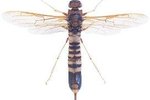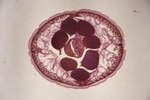
Cicadas must avoid a plethora of predators; hawks, lizards, turtles, frogs, fish, snakes and raccoons enjoy eating the plump insects. Nevertheless, the cicadas must avoid even more frightening creatures -- huge wasps that hunt them. These wasps don't intend to eat the cicadas. Instead, they seek to paralyze them, inject an egg into their bodies and bury them alive. Unfortunately, for cicadas that fall victim to this fate, their troubles are not over -- when the egg hatches, the larva will begin to eat the paralyzed insect.
Parasitic Wasps
Several hundred species of wasps live a parasitic lifestyle, in which some portion of the wasp’s life cycle takes place in or on a host species. The process usually kills the host, as the developing eggs, larvae or pupae withdraw nutrients from it. Most parasitic wasps exhibit extreme host specificity, and only use one host species.
Cicada Killer Basics
One parasitic species, the cicada killer (Sphecius speciosus) of the United States and Europe, uses cicadas as hosts for its eggs and larvae. Among the largest wasps, cicada killers reach nearly 2 inches in length. Their bodies are mostly black, with yellow markings designed to ward off predators. Their wings are large and orange and have black edges. Though the females have the ability to sting, they rarely do; males are often more aggressive, but they are incapable of stinging. While the larvae have chewing mouthparts and can eat meat, adults feed on flower nectar.
Cicada Killer Life Cycle
Adult cicada killers emerge at about the same time that cicadas emerge -- June and July. After mating, female cicada killers hunt for cicadas, and capture them alive with a venomous sting. The wasps then carry the paralyzed cicadas to their tubular burrows in which they place the cicadas; right before burying the paralyzed insects, the wasps place a single egg in each cicada. The females may capture a few more cicadas to place in their holes before eventually sealing them with dirt. Males die shortly after mating, while the females die shortly after completing egg deposition; by the end of August, all of the adults are dead. The eggs hatch into a larvae within a few days and feed on the cicadas as they grow and develop. A few weeks later, the larvae constructs cocoons that protect them until they pupate in the spring. Emerging in the summer, the new adults begin mating and capturing cicadas, perpetuating the species’ life cycle.
Pest Control
Parasitic wasps have a significant effect on the population of many other insects -- including pest species. Farmers and gardeners often use parasitic wasps and insect predators to help control the pest insect population, a technique called biological control. As cicadas are not destructive insects to most types of agriculture, cicada killers are not very helpful for biological control. However, farmers use many of the cicada killer’s relatives as biological pest control. One species, Trichogramma galloi' is a small wasp that lays its eggs in sugarcane borer larvae -- a species that causes great destruction to sugar cane crops. By releasing thousands of Trichogramma galloi eggs near farms afflicted by the sugarcane borer, farmers hope that the parasitic wasps will reduce the population of the destructive, boring insects.
References
- Animal Diversity Web: Sphenicus Speciosus
- Texas A&M Agrilife Extension: Cicada Killer
- University of Kentucky: Cicada Killer Wasps
- BBC News: Wasps v Moths -- Biocontrol Uses Nature Against Crop Pests
- Millard Fillmore's Bathtub: Cicadas, Cicada-Killer Wasps are Back!
- Iowa State University: Parasitic Wasps
- Texas A&M AgriLife Extension: Parasitic Wasps
Resources
Photo Credits
-
Jupiterimages/Photos.com/Getty Images




